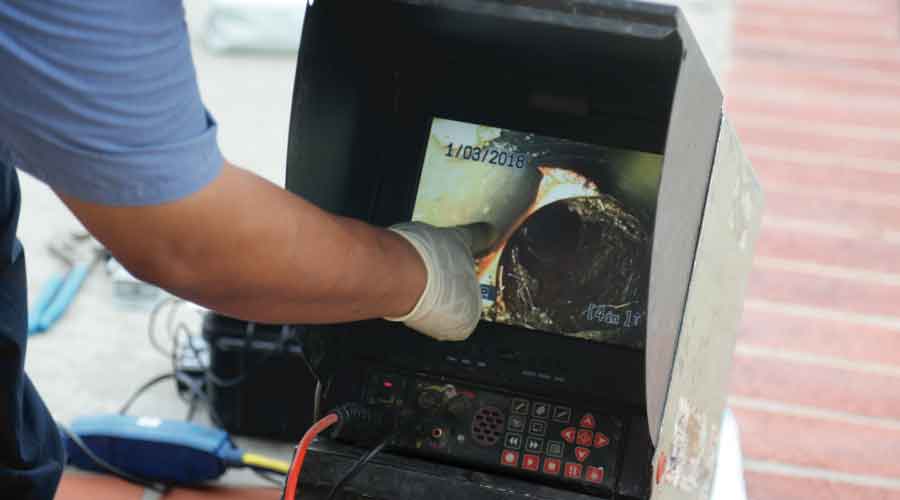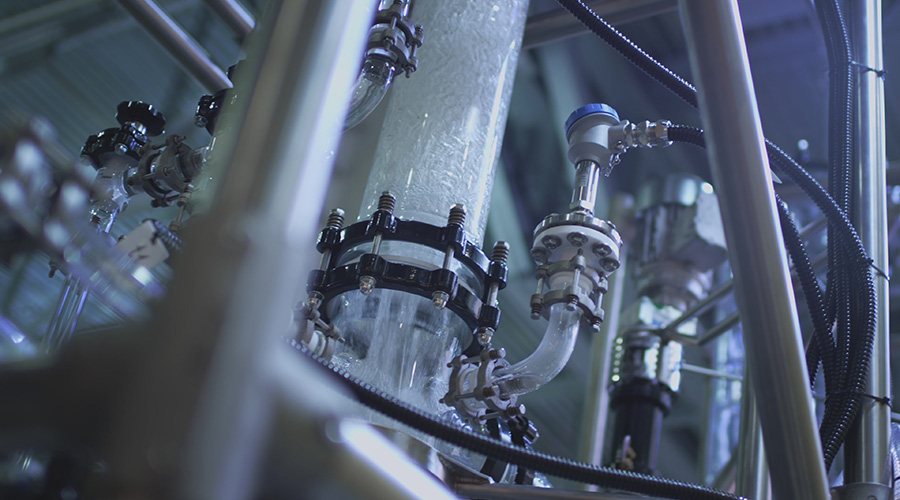How to Build a Successful Drain Cleaning Program
Product specification and technician training play vital roles in keeping facilities systems clean and functioning properly
Maintenance and engineering managers know that drain cleaning is a messy but essential part of operations in institutional and commercial facilities. The task involves everything from equipment selection and use to employee training and encyclopedic knowledge of local regulations.
“There is no one-size-fits-all solution for drain cleaners,” says Kathleen Keegan, group product marketing manager for Milwaukee Tool. “Because each application is unique, they need different equipment to service different line sizes to be successful in their business.”
For example, different tools are required for small fixture lines, large sewer lateral lines, and still others for line sizes in between. Managers also need to think about which solutions will make their front-line technicians more productive.
“Technicians need equipment that gives crews clearing power, performance, mobility, and safety to work their job efficiently and effectively,” Keegan says.
Equipment specification
Specification of equipment is “really critical,” says Mark Speranza, vice president of sales for Electric Eel Manufacturing.
“To properly maintain drain lines, a variety of equipment may be necessary to have on hand,” he says.
For example, smaller units are needed for one-quarter-, five-sixteenths-, or three-eighth- diameter drain openings for interior lines, such as sinks or tubs. A medium-sized unit for two-three lines with longer runs, a one-half-inch diameter cable of 75 feet is typical here.
“Will you be cleaning larger mainlines, such as 4-6-inch diameters 100 feet or longer?” Speranza asks. “If so, you will need a larger drum-style machine with a three-quarter inch diameter cable.”
A sectional unit is a good choice to clean distances of up to 200 feet. For technicians maintaining kitchens or other places where grease might be an issue, a high-pressure water jetter “does an excellent job,” Speranza says. “Also, you may want to consider an inspection camera for troubleshooting and locating pipelines.”
With the proper selection of equipment, Speranza says it can be much easier to set up regular maintenance on drain lines, which will prevent emergencies and extra time and expenses.
“One thing to avoid is purchasing equipment on price,” he says. “Starting with the best quality will save money in the long run.”
Keegan says the drain cleaning industry will continue to move toward solutions that are focused on increasing productivity.
“That productivity could come from overall process improvement, transportation improvements for heavy equipment, and overall new technologies for cleaning drain lines,” she says.
Employee training
Drain cleaning systems might be out of sight and out of mind, but the plumbing systems should be properly and regularly maintained regardless of their location or the materials that flow through them.
“Developing a maintenance plan will keep your plumbing system top of mind,” says Dave Parney, executive vice president of the Cast Iron Soil Pipe Institute, which conducts training for workers who conduct inspections and perform maintenance. “A maintenance plan will help facility management to budget effectively for system maintenance and diminish the likelihood of plumbing emergencies that could send building occupants reeling.”
Proper training not only keeps systems up and running effectively. It helps preserve equipment to ensure it lasts longer, saving maintenance departments money.
“All the right and best-quality equipment won’t do any good if employees don’t know how to operate it properly,” Speranza says. “Training is key if you expect to get the most out of your investment on drain tools.”
There is also a safety issue that comes with operating equipment without the proper training. In many cases, the manufacturer can provide training and even send a factory representative for local onsite training.
“Always start with safety” when training new employees on how to use drain cleaning machines, says Dave Dunbar, national sales manager for General Pipe Cleaners, a division of General Wire Spring Co. For instance, when using a drum-style cable machine, always use the power feed and guide tube. This practice physically separates the snake and the user.
“One of the biggest risks in drain cleaning is having the cable throw a loop or kink between the machine and the drain while the contractor has his hands on the snake,” Dunbar says. Using a power feed and guide tube eliminates that risk because no matter how much torque it is under, the cable cannot escape the guide tube and harm the user.
Until technicians receive expert instruction, they might think that wearing rubber gloves when operating a snake-style drain cleaning machine protects them from the health risks of sewage.
While it is true that drain cleaners should always understand that they are potentially in contact with human waste and should take the necessary safety precautions, operating a cable-style drain cleaning machine wearing only rubber gloves “is not one of them,” Dunbar says.
“The problem with rubber gloves is that they can become pinched and caught in the rotating coils of a drain cleaning cable, causing great harm to the operator,” he says. “We always recommend that operators wear heavy-duty two-ply leather gloves or something similar whenever their hands are anywhere near a drain cleaning machine.”
Thick leather gloves will not get caught between the coils of a snake or cable and will protect hands from unexpected kinks or loops that can form.
“If you want to wear rubber gloves to take appropriate sanitary precautions against sewage, then wear them under the leather gloves,” Dunbar says. “This strategy gives you two levels of protection.”
Mistakes to avoid
Drain cleaning mistakes are inevitable but usually avoidable when employees are trained in how to properly operate the equipment.
“Don’t break your stuff,” Dunbar says. “Let’s face it, drain cleaning is plenty hard enough without having to deal with equipment failures. When a drain-cleaning machine breaks on the job it can be dangerous, expensive and an enormous waste of time.”
Some examples of ways to preserve equipment include:
Snakes. Dunbar suggests technicians do not force the cable down the drain. Let the rotation of the snake do the work.
“Use it like a drill, not a battering ram,” he says.
After every job, they should drain the water out of the drums and spray or pour a lubricant into the drum and rotate it for a minute so the oil becomes evenly distributed on the cable.
Cutters. “We have found over the years that people tend to use too large a cutter for the job, and this can lead to lost and broken cutters as well as kinked cables,” Dunbar says. “We recommend starting with a smaller cutter, perhaps a spearhead or arrowhead cutter, something that will negotiate the twists and turns of the pipe and at least poke a hole through the obstruction.”
Jetter hoses. Most jetter hoses have a plastic or rubber-plastic composite coating. Although this gives them the flexibility they need, it also makes them susceptible to cuts and abrasion.
“Take care to keep them away from sharp edges, even before they go down the drain,” Dunbar says. “Be aware of your surroundings. Also, be careful not to scrape the hose as you feed it down the pipe. The rough edges on cast iron pipes can be very unforgiving to a jetter hose.”
Camera system pushrods. There are two primary ways that pushrods get damaged. They can be cut, scraped or suffer abrasions similar to a jetter hose, or they can kink. A kinked pushrod usually requires a re-termination to repair, which can cost $200-$500, Dunbar says.
“We recommend using short, fast motions instead of prolonged pressure to bounce pushrods around bends,” he says. “Keep one hand low, close to where the pushrod is entering the pipe — and most importantly, slow down.”
Work smart
Managers need to be aware of a host of local regulations that impact drain cleaning.
One local code requires cleanouts to be inserted in lateral drains every designated number of feet to facilitate drain cleaning and pipe inspection. Many municipalities also have instituted statutes requiring a lateral drain running from a building to be inspected whenever the property changes hands. The purpose of this inspection is to find and eliminate leaky pipes.
Dunbar says the common threads running through his suggestions are these:
Slow down. “Your drain cleaning and inspection equipment are money-making machines; treat them with respect.”
Maintain situational awareness. “Every job and job site is different. Look around and adjust accordingly.”
Lastly, make sure in-house technicians perform preventive maintenance immediately after every job to ensure tools are always working efficiently.
“How often do you break a cable?” Dunbar says. “When you do break a cable, what do you do? Do you fix it in the field, or take it back to the shop? How much time and money are really lost by your company because of equipment failures every year?”
Howard Riell is a freelance writer based in Hendersonville, Nevada.
Related Topics:












